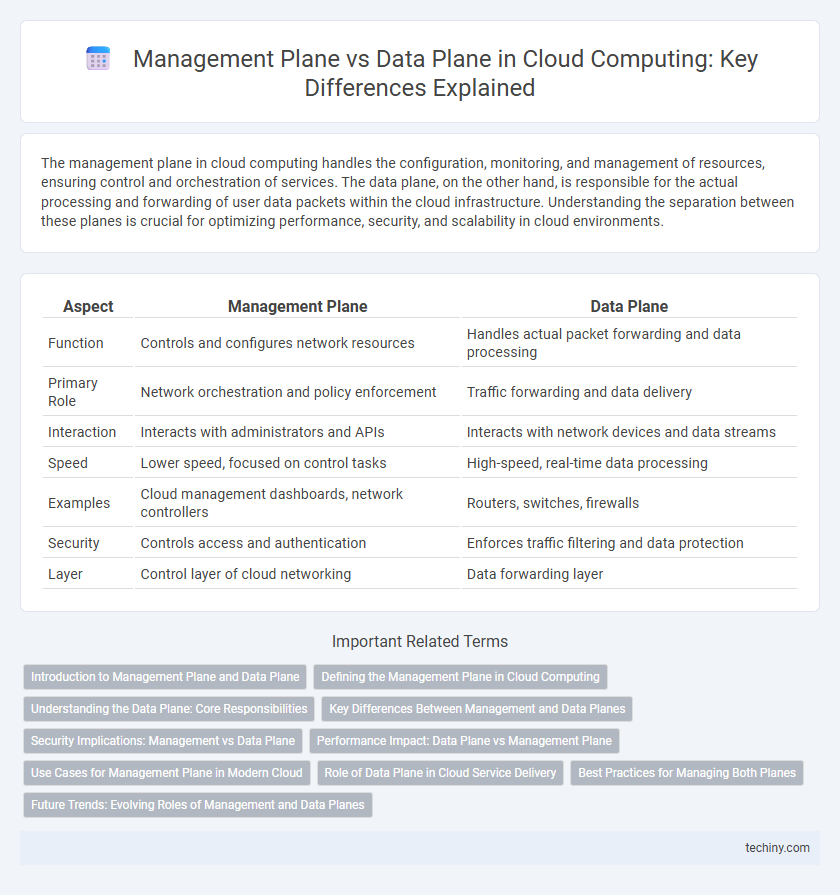The management plane in cloud computing handles the configuration, monitoring, and management of resources, ensuring control and orchestration of services. The data plane, on the other hand, is responsible for the actual processing and forwarding of user data packets within the cloud infrastructure. Understanding the separation between these planes is crucial for optimizing performance, security, and scalability in cloud environments.
Table of Comparison
| Aspect | Management Plane | Data Plane |
|---|---|---|
| Function | Controls and configures network resources | Handles actual packet forwarding and data processing |
| Primary Role | Network orchestration and policy enforcement | Traffic forwarding and data delivery |
| Interaction | Interacts with administrators and APIs | Interacts with network devices and data streams |
| Speed | Lower speed, focused on control tasks | High-speed, real-time data processing |
| Examples | Cloud management dashboards, network controllers | Routers, switches, firewalls |
| Security | Controls access and authentication | Enforces traffic filtering and data protection |
| Layer | Control layer of cloud networking | Data forwarding layer |
Introduction to Management Plane and Data Plane
The management plane in cloud computing is responsible for configuring, monitoring, and controlling the cloud infrastructure, enabling administrators to manage resources and policies efficiently. The data plane, in contrast, handles the actual flow of data packets and execution of user workloads within the cloud environment. Understanding the distinction between the management plane and data plane is essential for optimizing cloud performance, security, and scalability.
Defining the Management Plane in Cloud Computing
The management plane in cloud computing is responsible for orchestrating resources, handling configuration, monitoring system health, and ensuring security policies are enforced across the cloud environment. It provides administrators with tools and interfaces to control virtual machines, storage, networking, and application services. Efficient management plane operation is critical for maintaining scalability, reliability, and compliance in cloud infrastructure.
Understanding the Data Plane: Core Responsibilities
The Data Plane in cloud computing is responsible for processing and forwarding user data packets, ensuring efficient data flow across network devices. It operates at the hardware or software level to execute tasks like packet forwarding, filtering, and traffic shaping in real-time. This separation from the Management Plane allows the Data Plane to maintain high-speed data transmission essential for cloud service performance and scalability.
Key Differences Between Management and Data Planes
The management plane controls and configures network devices, handling policies, device management, and administrative tasks, while the data plane processes and forwards actual user data traffic within the network. The management plane operates out-of-band and interfaces with network administrators, whereas the data plane functions in-band, directly dealing with packet forwarding based on rules set by the management plane. Scalability and security are critical in the management plane for centralized control, whereas performance and low latency are priorities in the data plane to ensure efficient data delivery.
Security Implications: Management vs Data Plane
The security implications of the management plane versus the data plane in cloud computing are critical for maintaining robust infrastructure integrity. The management plane controls configuration, monitoring, and policy enforcement, making it a prime target for attackers aiming to gain administrative access and manipulate resources. In contrast, the data plane handles the actual data processing and transmission, requiring strong encryption, access controls, and monitoring to prevent data breaches and ensure confidentiality and integrity during data flow.
Performance Impact: Data Plane vs Management Plane
The Data Plane directly processes user data packets, resulting in high-throughput and low-latency performance essential for real-time applications. The Management Plane handles configuration, monitoring, and control tasks, which introduces minimal impact on data processing speed but is critical for orchestration and fault management. Optimizing the separation of these planes ensures efficient resource allocation and maximizes overall cloud infrastructure performance.
Use Cases for Management Plane in Modern Cloud
The management plane in modern cloud environments handles configuration, monitoring, and orchestration of resources, enabling automated deployment and policy enforcement across distributed systems. It provides centralized control interfaces for administrators to manage identity, access, and compliance, ensuring security and operational efficiency in complex cloud architectures. Use cases include real-time resource scaling, incident response automation, and audit logging for regulatory adherence.
Role of Data Plane in Cloud Service Delivery
The Data Plane in cloud computing is responsible for the actual processing and forwarding of user data, directly enabling service delivery by managing traffic flow and enforcing policies at the resource level. It operates as the core mechanism through which virtual machines, containers, and applications access network services and storage, ensuring low latency and high throughput. Effective data plane implementation enhances cloud performance, scalability, and security by isolating control functions from data processing tasks.
Best Practices for Managing Both Planes
Implement strict access controls and role-based permissions to secure the management plane, ensuring only authorized personnel configure cloud resources. Implement automated monitoring and logging for both management and data planes to detect anomalies, optimize performance, and maintain compliance standards. Regularly update and patch management plane interfaces and data plane components to mitigate security vulnerabilities and improve operational reliability.
Future Trends: Evolving Roles of Management and Data Planes
Future trends in cloud computing highlight the increasing decoupling and specialization of management and data planes, with management planes leveraging AI-driven automation for enhanced orchestration and policy enforcement. Data planes are evolving towards ultra-low latency processing and edge-native architectures to support real-time analytics and IoT workloads. This shift emphasizes distributed intelligence, enabling dynamic resource allocation and improved scalability across hybrid and multi-cloud environments.
Management Plane vs Data Plane Infographic

 techiny.com
techiny.com